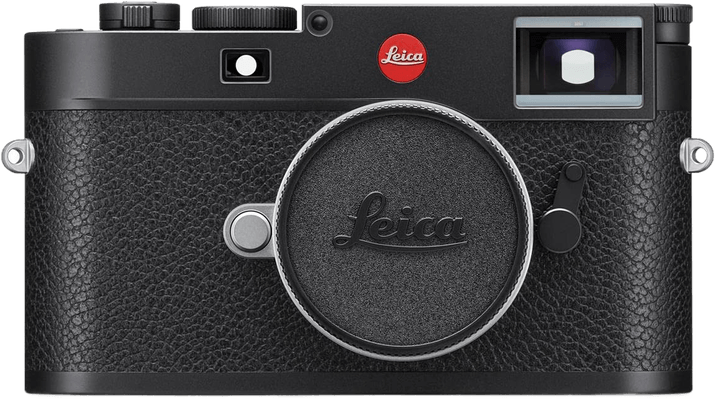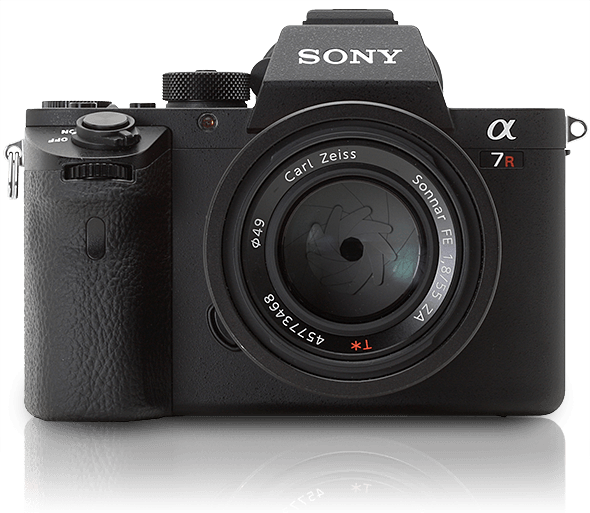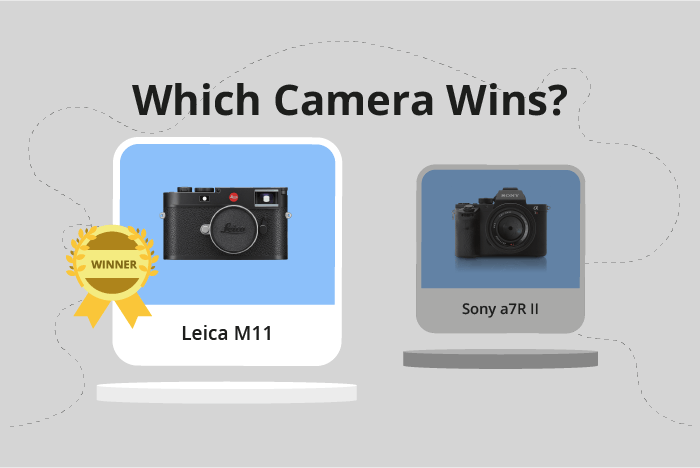Leica M11 vs Sony a7R II Comparison
Leica M11

Sony a7R II

The Leica M11 outperforms the Sony a7R II with a score of 74/100 compared to 70/100. Both cameras are mirrorless and share similarities in size and weight, with the Leica M11 measuring 139 x 39 x 80mm and weighing 640g, while the Sony a7R II measures 127 x 96 x 60mm and weighs 625g.
The Leica M11, released in 2022, has a higher launch price of $8995, reflecting its superior quality and features. On the other hand, the Sony a7R II, released in 2015, is more affordable with a launch price of $3198, making it a better option for budget-conscious buyers.
Given the difference in scores, the Leica M11 is a better camera overall, justifying its higher price. However, the Sony a7R II still offers decent performance at a lower cost. Ultimately, the choice between these two cameras depends on the user’s preferences and budget.
Leica M11 vs Sony a7R II Overview and Optics
The Sony a7R II wins in the optics comparison with a score of 81/100, while the Leica M11 scores 78/100. Both cameras share some specifications, such as having a CMOS sensor, a full-frame sensor size, and a similar shooting speed (4.5 for the Leica M11 and 5 for the Sony a7R II).
The Leica M11 excels with its 60-megapixel resolution, which is significantly higher than the Sony a7R II’s 42.4 megapixels. This allows the Leica M11 to capture more detail in images. Additionally, the Leica M11 has a superior DXOMARK sensor score of 100 compared to the Sony a7R II’s 98, indicating better overall image quality.
On the other hand, the Sony a7R II has some advantages over the Leica M11. Its faster shooting speed of 5 frames per second makes it more suitable for capturing fast-moving subjects. The Sony a7R II also features image stabilization, which the Leica M11 lacks. This can help reduce camera shake and produce sharper images, especially in low-light situations. Furthermore, the Sony a7R II uses the Sony FE lens mount, which offers a wider range of compatible lenses compared to the Leica M mount.
In comparing the optics of the Leica M11 and Sony a7R II, it is clear that both cameras have their strengths. The Leica M11 stands out for its higher resolution and better sensor score, while the Sony a7R II offers a faster shooting speed, image stabilization, and a broader lens compatibility. Depending on the photographer’s needs and preferences, each camera can provide a unique advantage in terms of optics.
Leica M11 vs Sony a7R II Video Performance
When comparing the video capabilities of the Leica M11 and the Sony a7R II, it is important to note that the Leica M11 does not have any video functionality. This means that for users who require video capabilities in their camera, the Leica M11 would not be a suitable option.
On the other hand, the Sony a7R II has a video score of 56 out of 100. This camera offers a maximum video resolution of 4K, with dimensions of 3840 x 2160 pixels. Its maximum video frame rate is 30fps. However, it is worth noting that the Sony a7R II does not have built-in time-lapse functionality.
Taking into account the video capabilities of each camera, it is clear that the Sony a7R II is the only option for those who need video functionality. The Leica M11, lacking video capabilities, would not serve the needs of users who require this feature.
Leica M11 vs Sony a7R II Features and Benefits
The Leica M11 outperforms the Sony a7R II in features with a score of 72/100 compared to 57/100. Both cameras share some common specifications, such as a 3-inch screen, Wi-Fi connectivity, and no Bluetooth. However, the Leica M11 excels in certain areas, making it the superior choice in terms of features.
One notable advantage of the Leica M11 is its higher screen resolution of 2,332,800 dots, compared to the Sony a7R II’s 1,228,800 dots. This results in a sharper and clearer display on the Leica M11, making it easier to review images and navigate menus. Additionally, the Leica M11 has a touchscreen, allowing for more intuitive control and quicker adjustments, while the Sony a7R II lacks this feature.
The Leica M11 also includes GPS, a useful feature for geotagging photos and tracking shooting locations. The Sony a7R II does not have GPS, making it less convenient for photographers who require location information for their work.
Despite its lower feature score, the Sony a7R II has one advantage over the Leica M11: a flip screen. This feature allows for more flexible shooting angles and is particularly helpful for capturing low or high-angle shots. The Leica M11 does not have a flip screen, limiting its versatility in certain situations.
Considering these points, the Leica M11 offers a better set of features, particularly in terms of screen resolution, touchscreen capabilities, and GPS. However, the Sony a7R II’s flip screen may be appealing to some photographers. Ultimately, the choice between these two cameras depends on the individual’s preferences and specific needs.
Leica M11 vs Sony a7R II Storage and Battery
The Leica M11 outperforms the Sony a7R II in storage and battery with a score of 45/100, compared to the Sony a7R II’s 16/100. Both cameras have one memory card slot and accept SD, SDHC, and SDXC cards. However, the Sony a7R II also supports Memory Stick Duo, Pro Duo, and Pro-HG Duo cards.
The Leica M11’s battery life excels at 700 shots per charge, using the BC-SCL7 battery. Additionally, it offers USB charging for added convenience. In contrast, the Sony a7R II falls short with 290 shots per charge, using the NP-FW50 battery, and lacks USB charging capabilities.
Despite the Sony a7R II’s lower score and battery life, it does provide more memory card compatibility. However, the Leica M11’s superior battery life and USB charging make it a more reliable option for extended shooting sessions.
Leica M11 vs Sony a7R II – Our Verdict
Are you still undecided about which camera is right for you? Have a look at these popular comparisons that feature the Leica M11 or the Sony a7R II:

